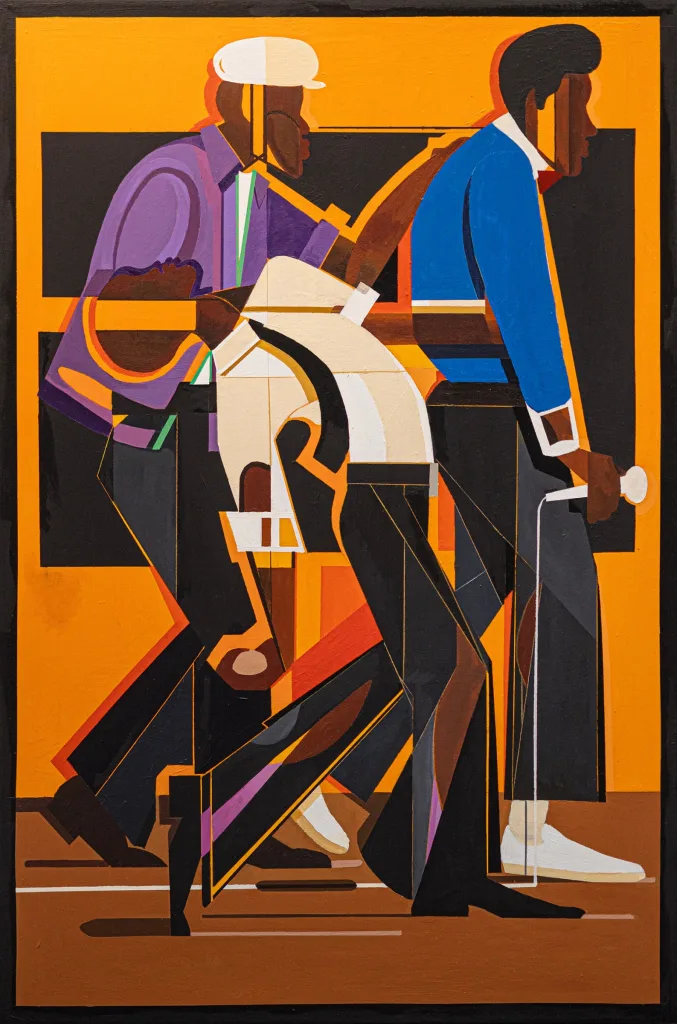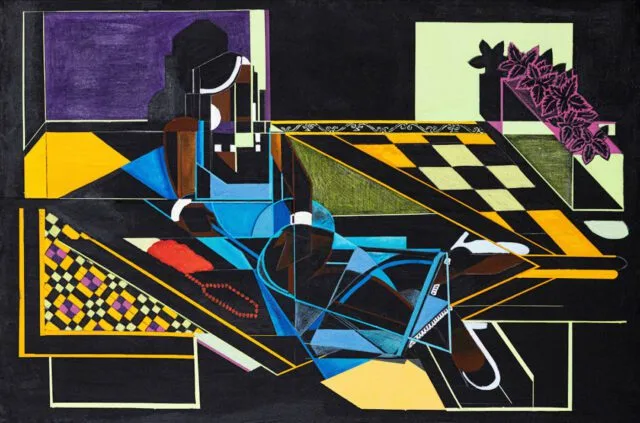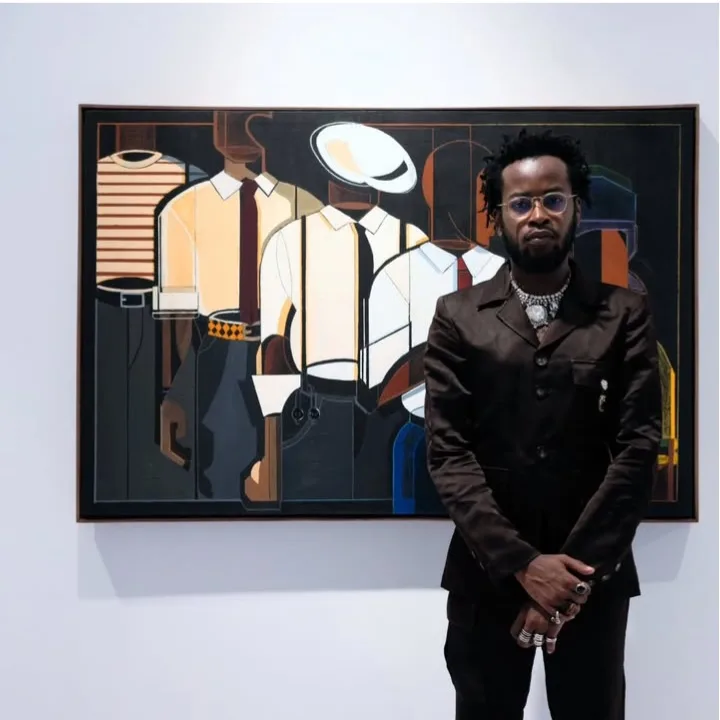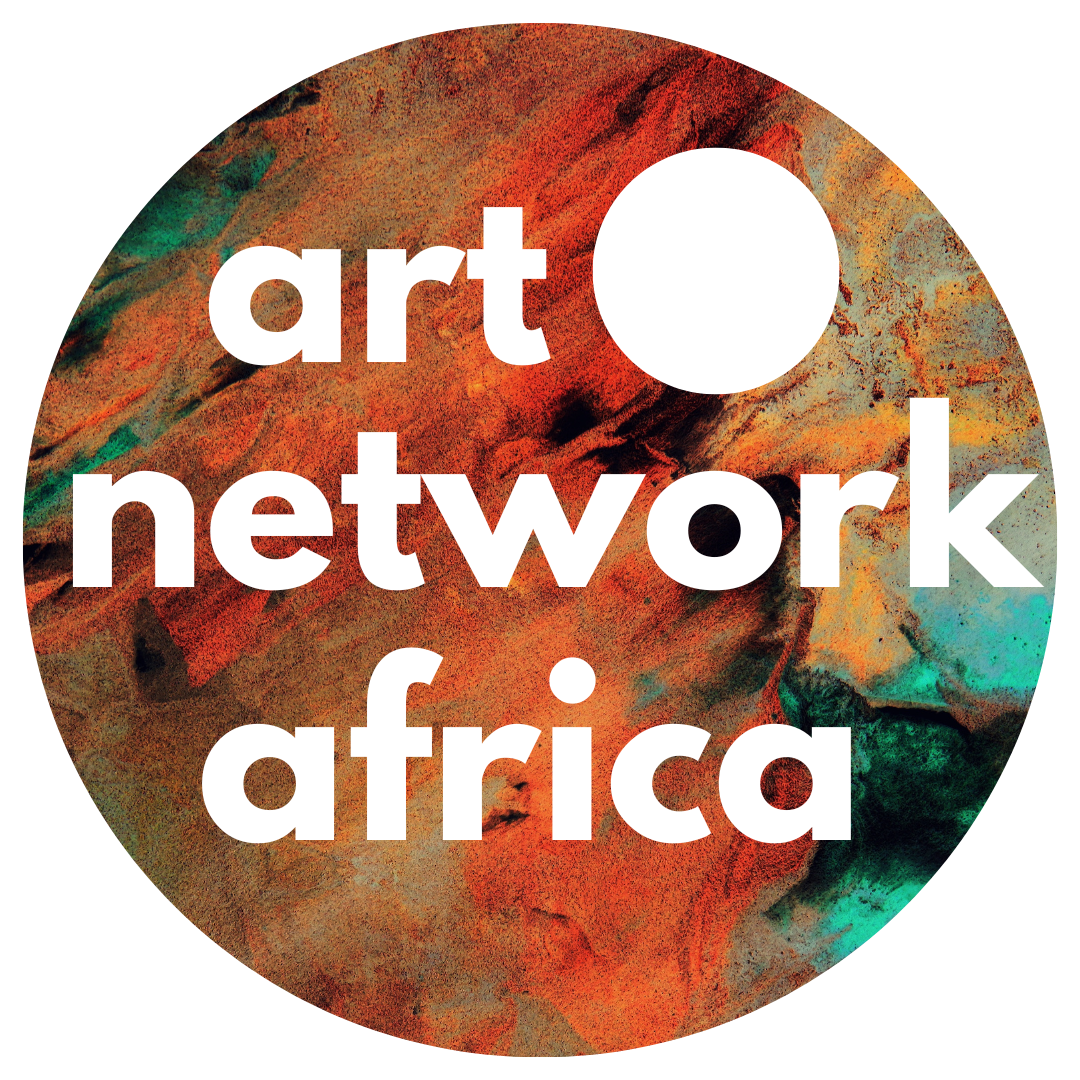Galerie Cécile Fakhoury is delighted to present ‘Goumbé’, the first solo exhibition by artist Carl-Edouard Keïta in Abidjan. At the dawn of independence, Côte d’Ivoire experienced an unprecedented economic boom, commonly referred to as the Miracle ivoirien (Ivorian Miracle). Many young people from rural areas and neighboring countries such as Guinea, Niger and Ghana migrated to Abidjan – the brand-new economic capital – full of hope and eager for new adventures, seeking employment, financial stability and a better future.
Together, these young migrants formed mutual aid associations known as Goumbés. Structured, codified and hierarchical, these associations bridged tradition and modernity and organised various activities fostering community cohesion. Through ‘Goumbé’, Carl-Edouard Keïta immerses viewers in the history of these communities and offers a reflection on regional migrations and their impact on the writing of contemporary Ivorian society.
The first Goumbé associations emerged as early as the 1940s, reaching their peak in the 1960s, the pivotal decade of African independence. Singing and dancing were at the heart of these groups. Through relentless rehearsals and hard work, their choreographic prowess and the magnetism of their songs drew crowds of onlookers and created moments of shared joy during performances held every Saturday night.

A defining and omnipresent sound was produced by the tambour jazz, a square drum with a military percussive style. This instrument symbolized cultural blending, migration and re-migration, as it was found on both sides of the Atlantic – in Jamaica, Benin,Ghana, Sierra Leone and Côte d’Ivoire. Like a guiding presence, it accompanied the young dancers, who, after their performances, were crowned king and queen of the Goumbé. Carl-Edouard Keïta, a true pictorial storyteller, through this solo exhibition reinterprets these performances and pays homage to these popular figures.
Ethnographic filmmaker Jean Rouch, in several of his films – including Moi, un noir (1958), La Pyramide humaine (1961), and La Goumbé des Jeunes Noceurs (1964) – attempted to capture what he described as the blindingly fast, dazzling movements of some of the finest dancers.
These films offer glimpses into their daily lives. In La Goumbé des Jeunes Noceurs, Jean Rouch introduces us to Nathalie, a discreet yet essential presence within the group – a mother by day and a movement magician by night. Inspired by her, new songs were composed every month to celebrate her endless feats. Keïta chooses to depict her with her child, using an intriguing interplay of shadows, as if to emphasise the limited knowledge we have of her fate.

The exhibition space also brings to life the figure of Gary Cooper, the greatest Goumbé dancer of his generation, as well as the Mandingo diva Diécoumba, the star singer of Treichville’s evening gatherings. The emotions stirred by their carefree and generous performances find their full expression in Keïta’s brushwork. His painted figures are not static; instead, they appear animated, echoing the circular and rhythmic movements of Goumbé dance. At the crossroads of cinematic, musical and choreographic references, this new body of work is also distinguished by a richer, more powerful chromatic background.
Shades of blue, yellow, violet and green intertwine, conversing in a masterfully composed visual harmony. This first solo exhibition in Abidjan marks the painter’s return to Côte d’Ivoire after more than ten years in New York. For the occasion, Carl-Edouard Keïta has delved into his family archives to offer viewers a sensitive portrayal of his relatives, in dialogue with the aesthetic and social transformations that have shaped Côte d’Ivoire. These unique sketches are displayed under glass, emphasising their preciousness and singular historical weight.

Six bronze sculptures, cast by artisans in the historic city of Grand-Bassam, further enrich the artist’s narrative, shedding light on the hybrid nature of the independence era. Ivorian women navigated between intricate traditional hairstyles and contemporary Western styles influenced by the yéyé period.
This hybridity is also evident in the cinema of Ivorian filmmaker Désiré Ecaré (see Visages de Femmes, 1985), which served as a primary inspiration for the sculptures. During this time, both local magazines (Ivoire Dimanche, Fraternité Matin, Avoura) and French publications (Salut les Copains) dictated trends for a youth caught between two worlds overlapping within them, as filmmaker Timité Bassori described in a conversation with the artist.
By capturing the subtleties, complexities, and rich intermingling of Ivorian contemporary history, this exhibition serves as a testimonial journey through the Goumbé universe – a dance of exile that has nearly vanished, even as its songs and movements persist in other forms within Malinkés communities.
This exhibition in Abidjan is also an opportunity for Carl-Edouard Keïta to further his artistic illumination of diasporic histories. He presents a race with major portraits in a profound act of transmission and absolute legacy. ‘Goumbé’ opened on the 13th of February and will run until the 12th of April 2025 at Galerie Cécile Fakhoury in Abidjan, Côte d’Ivoire.


